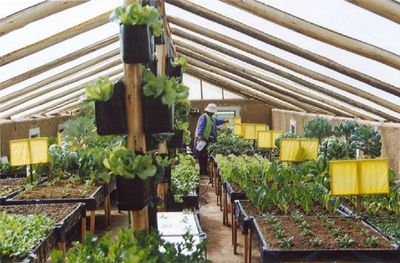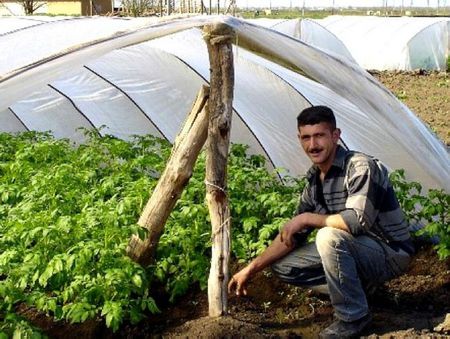Greenhouses
Main > Housing and construction
Main > Food and Agriculture > Controlled-environment growing
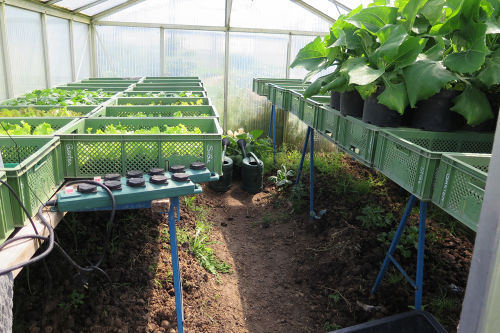
Aquaponics Greenhouse 2015 Video
Aquaponics Greenhouse Working Group 2015
NOW Sign up for Aquaponics Greenhouse Working Team 2015
Greenhouses are rooms that maximize natural light and can be used for controlled-environment growing. They may be stand-alone or part of a house. We aim to open source robust growing systems. This will empower people to grow high-value crops such as herbs - for self-sufficiency and for market.
Greenhouses need to stay warm all year round. This can be accomplished without using any energy at all - no electric heaters or fuel. A well-designed greenhouse can do this by using seasonal thermal store, heat sinks, insulation and maximising solar heat and light. In keeping with Open Ecology principles, we aim to gather information in the public domain that allows people to build cheap, effective, zero-energy greenhouses.
Greenhouses as a Part of the Home
Excerpt from A Pattern Language by Christopher Alexander:
"Imagine a simple greenhouse, attached to a living room, turned to the winter sun, and -filled with shelves for flowers and vege- tables. It has an entrance from the house—so you can go into it and use it in the winter without going outdoors. And it has an entrance from the garden—so you can use it as a workshop while you are out in the garden and not have to walk through the house.
This greenhouse then becomes a wonderful place: a source of life, a place where flowers can be grown as part of the life of the house. The classic conservatory was a natural part of countless houses in the temperate climates.
For someone who has not experienced a greenhouse as an ex- tension of the house, it may be hard to recognize how fundamental it becomes. It is a world unto itself, as definite and wonderful as fire or water, and it provides an experience which can hardly be matched by any other pattern. Hewitt Ryan, the psychiatrist for whom we built the clinic in Modesto with the help of this pattern language, thought greenhouses so essential that he included one as a basic part of the clinic: a place beside the common area, where people could reintegrate themselves by growing seedlings that would be gradually transplanted to form gardens for the clinic."
Inflatable greenhouses and Pillowdome
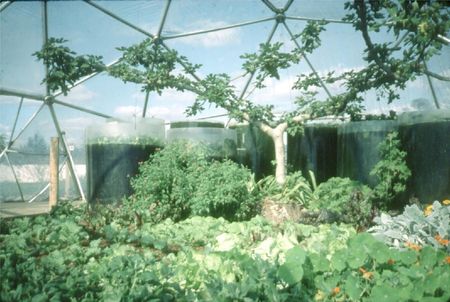
Nick says: Inflatable greenhouses such as this one would eliminate frame material and make for quick easy setup. The only trick would be creating a good seal around the air columns. Most greenhouse film is a UV resitant type of polyethylene and can be "welded". Here is a plastic welding kit for $288. There may be better ways of doing but the concept seems to have potential.
Bob says check out pillow domes - a kind of geodesic dome devised by Jay Baldwin (a Bucky Fuller student) with Argon-inflated pillows of long lived UV transparent plastic (Tefzel). The concept was later applied on a much larger scale in the Eden Project.
Passive solar greenhouses
Solar greenhouses incorporate special design features to maximize use of the Sun's heat so they can run without an input of energy. The article Those Remarkable Bolivian Solarhouses from Maximum Yield magazine describes a UN project in Bolivia. Over 300 solarhouses were built. They cost $6/m2 (56c per square foot) and proved themselves capable of growing warm-climate vegetables throughout winter high in the Andes without heaters. The article gives detailed descriptions of how they are built.
The design needs to do two things in order to achieve a comfortable growing temperature year-round: firstly, to maximise the use of the Sun's heat and light and secondly, to create a 'thermal mass' effect i.e. include elements that do not change temperature easily, to stabilize the indoor temperature.
Solar greenhouse design features can include -
- Low walls, only 100-120cm high (39-47 inches), painted black. Made of adobe and straw. For OSE, Superinsulated CEB Construction would be perfect. Alternatively, the floor could be sunk below ground level to provide better thermal mass, but this would require more labour to build.
- A domed or sloped roof of wooden poles stretched over clear polyethylene sheeting
- "Small windows are constructed in the adobe walls to allow for opening and closing to raise or lower temperature"
- The floor can be painted black or covered with something black to increase the heat it stores.
- If thermal mass needs to be increased more, fill black plastic bags with gravel or sand; these will store heat. In the Bolivian project, two liter bottles were painted black and filled with sand for this purpose. Black stones can also be used.
- Water tanks also act as a heat store. It might be worth considering aquaponics in a solar greenhouse, as a large fishtank will regulate the temperature of the room. A large rainwater catchment, painted black, will work too.
Earth Sheltered and Walipini greenhouses
A greenhouse can be built by digging a hole in the ground and covering it with glass. This takes advantage of the heat stored in the earth during the cold season (warmth in winter, cooling in summer). It is an adaptation of the idea of passive annual heat storage (PAHS) to the greenhouse. Therefore very suitable for climates with cold winters. At the depth of several meters, there is very little seasonal variation in temperature. The earth around the greenhouse structure has large thermal mass.
The Benson Agriculture and Food Institute at Brigham Young University examined the concept in detail and has put together a manual with specific designs (File:Walipini.pdf). These underground greenhouses are called "Walipini" (pit greenhouse) in South America. The Benson Institute's experiment was built in Bolivia, high up in the Andes where it gets really cold. Their greenhouse costs $250-$300 in materials and is designed to provide vegetables year-round for seven people. They recommend a minimum of 94 square feet (less than 8.75m2) of growing space per person.
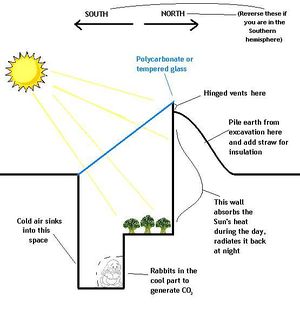
Mike Oehler of UndergroundHousing.com, described a similar concept in The Earth-Sheltered Solar Greenhouse Book, available here. This is an adaptation from his earlier work on underground housing for residential purposes.
Some Walipini Design Alterations Sugestions have been made.
Sloped Greenhouse
Greenhouse Tips & Ideas with Shawn Jadrnicek:
FAO booklet: solar and Chinese greenhouse
8. Solar house
8.1. The combined passive solar energy training building
8.2. The passive and active combined solar working office
9. Research on the temperature environment of solar greenhouse
9.1. The temperature simulation and structural optimization of the solar greenhouse
9.2. The underground heat exchange system of protected vegetable cultivation
9.3. The benefit of vegetable production in the underground heat exchange solar greenhouse
10. Integrated energy self-served animal and plant complementary ecosystem in China
10.1. Introduction (about CO2 enrichment)
10.2. History and principle of the integrated energy self-served animal and plant complementary producing system
10.3. The investigation of the problems of the integrated energy self-served ecosystem
10.4. The structure improvement of the energy self-served animal and plant complementary ecosystem
10.5. The study and test of the ventilation system in the E-W form of the ecosystem
Product Ecology
- Biochar to improve soil
- Aquaponics to produce fish, fertilize plants and buffer temperature.
- Integrated Food and Waste Management System
- Organoponic Raised Bed Gardening
- Vermicompost to improve soil and to feed fish if aquaponics is used
- Black Soldier Fly to produce compost. Larvae can feed fish if aquaponics is used
- CEBs and Superinsulated CEB Construction
- compressed air for ventilation
- Plastic extruder for pipes and glazing with stuff like polycarbonate
- Rabbits to produce CO2 and compost
- Mushrooms to produce CO2 (fungi inhale oxygen and exhale CO2 like animals) and make compost from wood
- Hydronic Heat System
Related Wiki Pages
- Chinese Greenhouse
- Greenhouse Cultivation of Staple Crops
- Geodesic domes
- Organoponic Raised Bed Gardening
- Fluoropolymers
